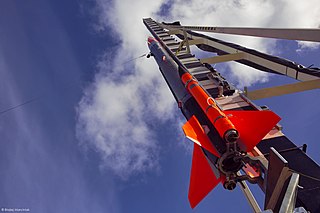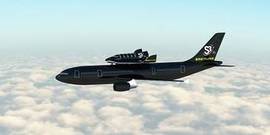 W
WThe Black Brant is a family of Canadian-designed sounding rockets originally built by Bristol Aerospace, since absorbed by Magellan Aerospace in Winnipeg, Manitoba. Over 800 Black Brants of various versions have been launched since they were first produced in 1961, and the type remains one of the most popular sounding rockets ever built. They have been repeatedly used by the Canadian Space Agency and NASA.
 W
WCopenhagen Suborbitals is an amateur crowd-funded, non-open source human space programme. Since its beginning in 2008, Copenhagen Suborbitals has flown five home-built rockets and two mock-up space capsules. Their stated goal is to have one of the members fly into space, on a sub-orbital spaceflight, in a space capsule on the Spica rocket. The organisation was founded by Kristian von Bengtson and by Peter Madsen, who was convicted of the murder of Kim Wall in 2017. Peter Madsen was excluded from Copenhagen Suborbitals in 2014. The organization successfully launched its Nexø II rocket in summer 2018.
 W
WThe Crew Module Atmospheric Re-entry Experiment (CARE) is an experimental test vehicle for the Indian Space Research Organisation's future ISRO orbital vehicle called Gaganyaan. It was launched successfully on 18 December 2014 from the Second Launch Pad of the Satish Dhawan Space Centre, by a GSLV Mk III designated by ISRO as the LVM 3X CARE mission. Total cost of mission was ₹155 crore. Cost of launch vehicle and CARE module was ₹140 crore and ₹15 crore.
 W
WThe Dragon 2 DragonFly was a prototype suborbital rocket-powered test vehicle for a propulsively-landed version of the SpaceX Dragon 2. DragonFly underwent testing in Texas at the McGregor Rocket Test Facility in October 2015. However, the development eventually ceased as the verification burden imposed by NASA was too great to justify it.
 W
WFalcon 9 prototypes were experimental flight test reusable rockets that performed vertical takeoffs and landings. The project was privately funded by SpaceX, with no funds provided by any government until later on. Two prototypes were built, and both were launched from the ground.
 W
WHEAT 1X Tycho Brahe was the first rocket and spacecraft combination built by Copenhagen Suborbitals, a Danish organization attempting to perform the first amateur suborbital human spaceflight. The vehicle consisted of a motor named HEAT-1X and a spacecraft Tycho Brahe. Its launch location was a floating platform named Sputnik. The rocket was test launched twice: In 2010 a power shortage caused a valve to freeze shut, which prevented launch. In 2011 the rocket was successfully launched, reaching an altitude of 2.8 kilometres (1.7 mi) before the engine was remotely shut off due to a wrong trajectory.
 W
WILR-33 AMBER – Polish multistage suborbital rocket designed by Warsaw Institute of Aviation – Łukasiewicz Research Network. The mail goal of development of AMBER is gaining experience in building rocket engines and rockets themselves. AMBER can be used in sounding the atmosphere, performing various experiments in microgravity and as a rocket and space technologies testing platform.
 W
WThe Intermediate eXperimental Vehicle (IXV) is a European Space Agency (ESA) experimental suborbital re-entry vehicle. It was developed to serve as a prototype spaceplane to validate the ESA's work in the field of reusable launchers.
 W
WThe Kuwait Space Rocket (KSR), is a Kuwaiti project to build and launch the first suborbital liquid bi-propellant rocket in Arabia. The project is intended to be the first step towards starting a space industry in the country and a launch service provider in the GCC region. The project is divided into two phases with two separate vehicles. An initial testing phase with KSR-1 as a test vehicle capable of reaching an altitude of 8 km (5.0 mi) and a more expansive suborbital test phase with the KSR-2 planned to fly to an altitude of 100 km (62 mi).
 W
WMercury-Redstone 1A (MR-1A) was launched on December 19, 1960 from LC-5 at Cape Canaveral, Florida. The mission objectives of this uncrewed suborbital flight were to qualify the spacecraft for space flight and qualify the system for an upcoming primate suborbital flight. The spacecraft tested its instrumentation, posigrade rockets, retrorockets and recovery system. The mission was completely successful. The Mercury capsule reached an altitude of 130 miles (210 km) and a range of 235 miles (378 km). The launch vehicle reached a slightly higher velocity than expected - 4,909 miles per hour (7,900 km/h). The Mercury spacecraft was recovered from the Atlantic Ocean by recovery helicopters about 15 minutes after landing. Serial numbers: Mercury Spacecraft #2 was reflown on MR-1A, together with the escape tower from Capsule #8 and the antenna fairing from Capsule #10. Redstone MRLV-3 was used. The flight time was 15 minutes and 45 seconds.
 W
WNew Shepard is a vertical-takeoff, vertical-landing (VTVL), crew-rated suborbital launch vehicle that is being developed by Blue Origin as a commercial system for suborbital space tourism. Blue Origin is owned and led by Amazon.com founder and businessman Jeff Bezos and aerospace engineer Rob Meyerson. NASA Silver Snoopy Award winner Robert Smith is the company's chief executive officer.
 W
WSISTINE is a NASA mission designed to study distant stars as a way of finding life on exoplanets.
 W
WSkylark was a British sounding rocket design. The Skylark was first launched in 1957 from Woomera, Australia and its 441st and final launch took place from Esrange, Sweden on 2 May 2005. Launches had been carried out from sites in Europe, Australia, and South America, with use far beyond the UK by NASA, the European Space Research Organisation (ESRO), and German and Swedish space organizations.
 W
WSOAR was a partially reusable air-launched spaceplane launch system concept designed to launch small satellites on a suborbital or orbital trajectory. The vehicle, derived from the Hermes spacecraft developed by the European Space Agency, was planned to be built, launched, and operated by Swiss Space Systems. The spaceplane was planned to launch from an Airbus A300 aircraft named S3 Zero Gravity Airliner. Once at altitude, the spaceplane was planned to separate from the aircraft and ignite an NK-39 engine developed by the Russian Federal Space Agency. After fuel depletion at about 80 kilometers altitude, the plane was planned to release its payload before gliding back and landing on Earth.
 W
WSpaceport America—formerly the Southwest Regional Spaceport—is an FAA-licensed spaceport located on 18,000 acres of State Trust Land in the Jornada del Muerto desert basin in New Mexico, United States directly west of and adjacent to U.S. Army's White Sands Missile Range. It lies 89 miles (143 km) north of El Paso, 45 miles (72 km) north of Las Cruces, and 20 miles (32 km) southeast of Truth or Consequences.
 W
WSpaceShipOne is an experimental air-launched rocket-powered aircraft with sub-orbital spaceflight capability at speeds of up to 900 m/s (3,000 ft/s), using a hybrid rocket motor. The design features a unique "feathering" atmospheric reentry system where the rear half of the wing and the twin tail booms folds 70 degrees upward along a hinge running the length of the wing; this increases drag while retaining stability. SpaceShipOne completed the first crewed private spaceflight in 2004. That same year, it won the US$10 million Ansari X Prize and was immediately retired from active service. Its mother ship was named "White Knight". Both craft were developed and flown by Mojave Aerospace Ventures, which was a joint venture between Paul Allen and Scaled Composites, Burt Rutan's aviation company. Allen provided the funding of approximately US$25 million.
 W
WThe Scaled Composites Model 339 SpaceShipTwo (SS2) is an air-launched suborbital spaceplane type designed for space tourism. It is manufactured by The Spaceship Company, a California-based company owned by Virgin Galactic.
 W
WAs of 2020, SpaceX operates four launch facilities: Cape Canaveral Space Launch Complex 40 (SLC-40), Vandenberg Air Force Base Space Launch Complex 4E (SLC-4E), Kennedy Space Center Launch Complex 39A (LC-39A), and Brownsville South Texas Launch Site. Space Launch Complex 40 was damaged in the Amos-6 accident on September 2016 and repair work was completed by December 2017. SpaceX believes that they can optimize their launch operations, and reduce launch costs, by dividing their launch missions amongst these four launch facilities: LC-39A for NASA launches, SLC-40 for United States Space Force national security launches, SLC-4E for polar launches, and South Texas Launch Site for commercial launches.
 W
WThe North American X-15 is a hypersonic rocket-powered aircraft. It was operated by the United States Air Force and the National Aeronautics and Space Administration as part of the X-plane series of experimental aircraft. The X-15 set speed and altitude records in the 1960s, reaching the edge of outer space and returning with valuable data used in aircraft and spacecraft design. The X-15's highest speed, 4,520 miles per hour, was achieved in October 1967, when William J. Knight flew at Mach 6.70 at an altitude of 102,100 feet (31,120 m), or 19.34 miles. This set the official world record for the highest speed ever recorded by a crewed, powered aircraft, which remains unbroken.